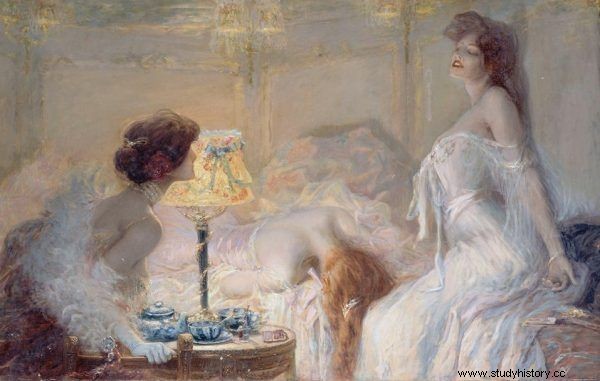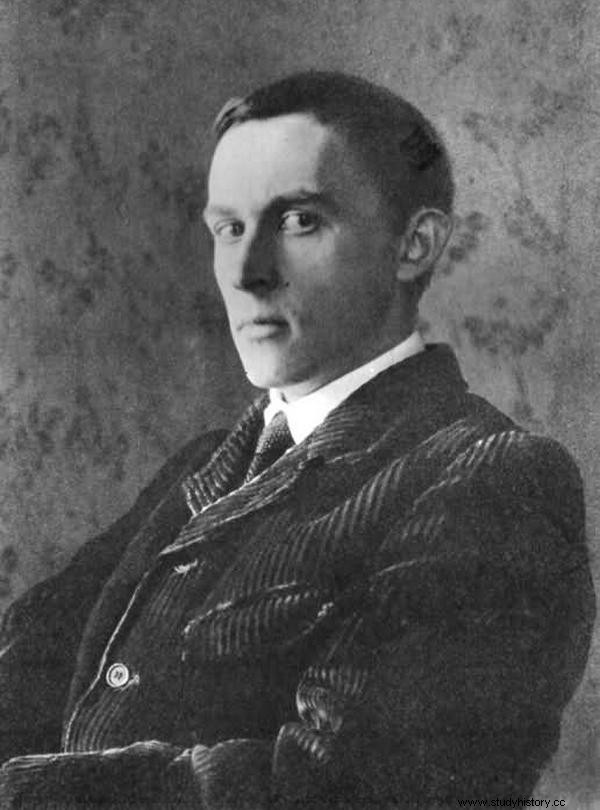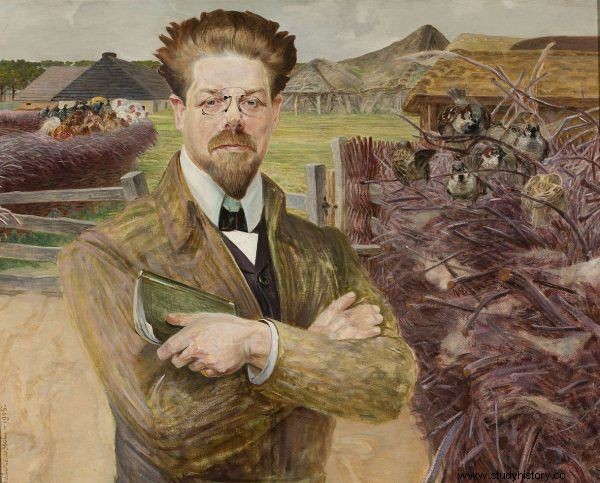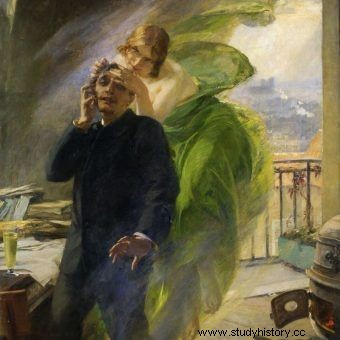Ether, morphine, wine mixed with cocaine ... Psychotropic substances enjoyed great popularity at the turn of the 19th and 20th centuries. Artists excelled in their use, claiming that they broaden the perception and support the imagination. But this does not mean that ordinary bread eaters did not reach for them either.
The last decades of the 19th century saw an increase in the popularity of narcotic drugs. The phenomenon was fostered by the development of chemistry and medicine, which constantly provided new substances for testing. Taking it was also simply fashionable. Modernism and decadence reigning in the artistic salons of Europe went hand in hand with the abuse of drugs and alcohol.
Eteromania
Ether was a popular stimulant drug. In the early nineteenth century, public speakers used it to improve eloquence . Only after that were the pleasant sensations he gave was discovered. In moderate amounts, it warmed you up and improved your mood. Gradually, it gained more and more followers, and finally at the end of the 19th century, "eteromania" became a common phenomenon. This is how it was written about the action of the substance:
Visual and auditory hallucinations, dreams of heavenly happiness, music to the ear, visions of beautiful women and sensual pleasures, and many other delusions - this is what happens to people under his influenced.

Ether was a real salvation for patients who had to undergo surgery. However, it quickly became a cheap and easily accessible drug for many. The picture shows a painting by Ernest Board (source:public domain).
The popularity of ether, also in liquid form (for drinking), continued in Poland even in the interwar period. The phenomenon reached such a scale that in 1923 the Seym banned the sale of ether for consumption purposes. Five years later, he was extended into drug law.
Wine with cocaine
In 1860 cocaine was extracted from coca leaves. It was quickly realized that the new substance added strength and increased endurance. It began to be used in medicine ... and also to be taken recreationally or for strengthening during heavy exercise. It was taken regularly by Sigmund Freud, who wrote about his reaction to a dose of the drug: I have the strength of a lion, I am healthy and happy .
Cocaine was used by writers before starting work and by travelers during their expeditions. It was also given to soldiers. It was also used to strengthen other, more classic stimulants:the stimulating drug was added to ... wines. Cocaine itself has been touted as a "unique, easily digestible stimulant."
The most famous Polish supporter of the strengthening substance was Stanisław Ignacy Witkiewicz. He even made one of the heroes of his famous novel "Farewell to Autumn", Count Łohoyski, a cocaine player. The drug obtained from the Peruvian plant is also used by the main character of "Farewell ...", Athanasius Bazakbal, for whom it acts as an aphrodisiac . Despite this, cocaine men did not have good press in the 1920s. Here is how they were characterized:
These are usually well-off people who usually encountered the drug for the first time voluntarily wanting to experience unknown impressions, quite a lot of deviations occur between cocaine users ...
Morphine - a miracle cure
Cocaine was considered safe enough ... it was also used as a remedy for drug addiction. For example, morphine, another popular stimulant at the turn of the 19th and 20th centuries. It made its debut as a "miracle cure" for indigestion and heart disease. Injecting it was thought to be free from the ill effects of opium.

Morphine was initially considered a "wonder drug". However, it quickly became a real scourge. The illustration shows the painting by Albert Matignon "Morphine" (source:public domain).
Over time, however, it has been discovered that morphine is not only enjoyable, but also quickly and strongly addictive. Meanwhile, circles addicted to it grew, and morphineism became fashionable in the circles of bohemian art . For example, the somewhat forgotten poet Włodzimierz Stebelski (1848-1891) fell into his claws. Let us quote a fragment of his poem under the meaningful title "The House of the Insane":
There in the corner there is a very pale
Lady of high sphere company.
The idiotic gaze falls all around,
Formerly rich in glow cheerful, honest;
He remembers nothing, tells nothing
From the past life of his chimera.
She went mad to her misty lands
Through the poison of poisonous morphine and cocaine.
One of the heroes of Eliza Orzeszkowa's "On the Nemunas" - Teofil Różyc, was a morphinist. Stanisław Ignacy Witkiewicz also took her. The increase in addiction to this substance was brought about by the First World War. Back then, morphine was widely used as an anesthetic. It was also eagerly used by the doctors themselves, working for many hours, dropping off in the middle of the night to go to the patient and struggling with difficult cases. Young medics in the use of morphine were probably ahead of only members of the bohemian art ...

Witkacy (source:public domain) was a morphinist.
Opium instead of beer
Another common substance, opium, has been used as a painkiller, sedative, sleep-inducing drug, and intoxicating drug. It was taken mainly in the form of an alcohol tincture called laudanum, or it was smoked. Opium-based medications were prescribed en masse by doctors to women suffering from menstrual pain. They were also given to children as a cough remedy. Substance addiction became a real social problem only when opium smokers became popular in Europe and the USA in the second half of the 19th century.
They were gloomy, dark rooms. Men of all ages were lying in strange positions on mattresses or sofas by the walls among the fumes of smoke. . Some had already lost consciousness under the influence of the drug, others were just holding long pipes in their hands and were dragging another dose to get the long-awaited departure.
Opium smoking rooms were so common in nineteenth-century reality that they made their way into the pages of novels. Their popularity was associated with the relatively low price of the drug. Charles Baudelaire, author of the dissertation "The Opium Eater," wrote, for example, that for workers from opium manufactories, it is the cheapest entertainment, because due to low wages they cannot afford beer or vodka .

Paris opium smoking room from the turn of the 19th and 20th centuries. Illustration from Le Petit Journal (source:public domain).
Reymont - Opium sympathizer
Among Poles, opium enthusiasts were the young Polish poets Jan Kasprowicz, Tadeusz Miciński and Kazimierz Przerwa-Tetmajer. It was also used by the less known poet of Young Poland, Kazimiera Zawistowska (1870-1902).
It was she who translated the poems of Baudelaire, "opiumist, alcoholic, hashish, decadent". She herself wrote dreamlike, narcotic lyrics. Sometimes she even transferred opium hallucinations to paper, as in the poems "Lions" and "About purple poppies ...".

Władysław Reymont, among others, spoke positively about the experience of smoking opium. The illustration shows a portrait of our future Nobel Prize winner by Jacek Malczewski (source:public domain).
Władysław Reymont was also a fan of opium. He wrote the story "In the opium smoking room", in which he positively described the experience of taking this substance during a visit to the title premises. Let us add that opium was probably used by Juliusz Słowacki and Fryderyk Chopin. The title character of Słowacki's poem "Lambro" is an opiumist ...
Haszysz, or peace and love
Hashish, or cannabis resin extract, became fashionable in the 19th century among artistic bohemians. The French 'hashish club' included painters such as Eugène Delacroix and writers such as Gustave Flaubert, Honoré de Balzac and Victor Hugo. They smoked or ate hashish in the form of preserves with added sugar, spices and almonds which was meticulously noted by Baudelaire, the author of another valuable dissertation "Wine and Hashish".

At the end of the 19th century, absinthe was an extremely popular intoxicant. The illustration shows a fragment of Albert Maignan's painting "The Green Muse" (source:public domain).
Draw in smoke three times, then peace and love Oscar Wilde wrote. Among native artists, the aforementioned poets like Jan Kasprowicz, Tadeusz Miciński and Kazimierz Przerwa-Tetmajer liked hashish. This is what Kamil Sipowicz, a contemporary supporter of stimulants, writes about the Young Poland approach to opium and hashish:
Nihilism and Bergson's surrender to emotional power were favored by hashish and opium. These two inventions of the Orient threw the poet into the world beyond the bourgeois and philistine norms in one fell swoop. They stimulated the imagination of an uncontrolled flow of experiences.
A herbal departure in the Polish countryside
Cocaine, morphine, opium and hashish, however, do not exhaust the list of drugs used by our great-grandparents for intoxication. They had a truly cool specialty first aid kit . The list of plants containing narcotic substances that were used in the Polish countryside at the beginning of the 20th century is impressive. You can find here the marsh blueberry, calamus, common hoof, hops, datura, black hen, marsh, as well as red toadstool and ergot. Of course, poppy and hemp were also used.
Two hallucinogenic plants, Datura and Nightshade, were most likely tried by Jan Kasprowicz. This is indicated by the titles of two poems he wrote, "Datura Stramonium Bieluń" and "Solanum Nigrum Psianka" ...
However, they did not stop at natural resources, they also reached for various chemicals, such as chloral, chloroform, amyl nitrite, arsenic, nitrous oxide, chlorodyne ... Everything that was good to "fly away" and get away from the sad reality was good.

Jan Kasprowicz probably used domestic intoxicants. The illustration shows a portrait of the poet by Jacek Malczewski (source:public domain).
Have you been aware of the harmful effects of these substances? It's hard to say, especially considering that "medicinal" products - syrups, tinctures, pastilles and others - with the addition of opium or hemp could be purchased at any pharmacy .
Alcohol above all
Despite the availability of a huge amount of intoxicating substances, the most popular drug of our great-grandparents - and whether they were artists or simple peasants - was alcohol. It was he who reliably allowed one to enter a state of intoxication, relaxation, euphoria or sleep - whatever you prefer. Especially among the bohemians of Young Poland, alcohol was flowing in torrents ...
Wine, vodka, cognac and absinthe were drunk. The latter, known as the Green Fairy, has become an alcoholic symbol of those times. Addiction to alcohol was perhaps even more common than addiction to narcotic drugs. Drunkenness organized in Krakow by Stanisław Przybyszewski and his company has gone down in legend.

Absinthe became an alcohol symbol at the turn of the 19th and 20th centuries. The illustration shows the painting "The Drunkard of Absinthe" by Viktor Oiva (source:public domain).
Stach himself - as Tadeusz Boy-Żeleński who knew him well wrote - was an alcoholic and poured three quarters of cognac into his tea . Stachu (...) suffered from an eternal lack of money. Well, unless it was alcohol, then he managed to get the amount needed to buy another flask out of the ground - we read in the book "W oparach absinthe. Young Poland scandals ”.
Drinking was a duty when surrounded by Przybyszewski. He himself was driven by alcohol for most of his life. For this reason, Wyspiański was not among his admirers, who had a strong aversion to drunkenness. Meanwhile, at the end of his life, Przybyszewski's addiction was cruelly mocked. During a serious illness, the doctors forbade him to drink. But that his wife liked alcoholic drinks, she bought wine and liqueurs, poured some of her sick husband down the throat of her sick husband, and the rest she drank herself ...
Bibliography:
- Iwona Kienzler, In the mist of absinthe. Scandals of Young Poland , Bellona 2017.
- Richard Davenport-Hines, intoxicated. History of drugs 1500-2000 , W.A.B. 2006.
- Kamil Sipowicz, Encyclopedia of Polish psychedelia , Krytyki Polityczna Publishing House 2013.
- Tadeusz Boy-Żeleński, Did you know this country? , National Institute for them. Ossoliński 2004.
